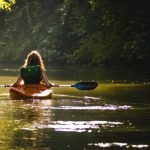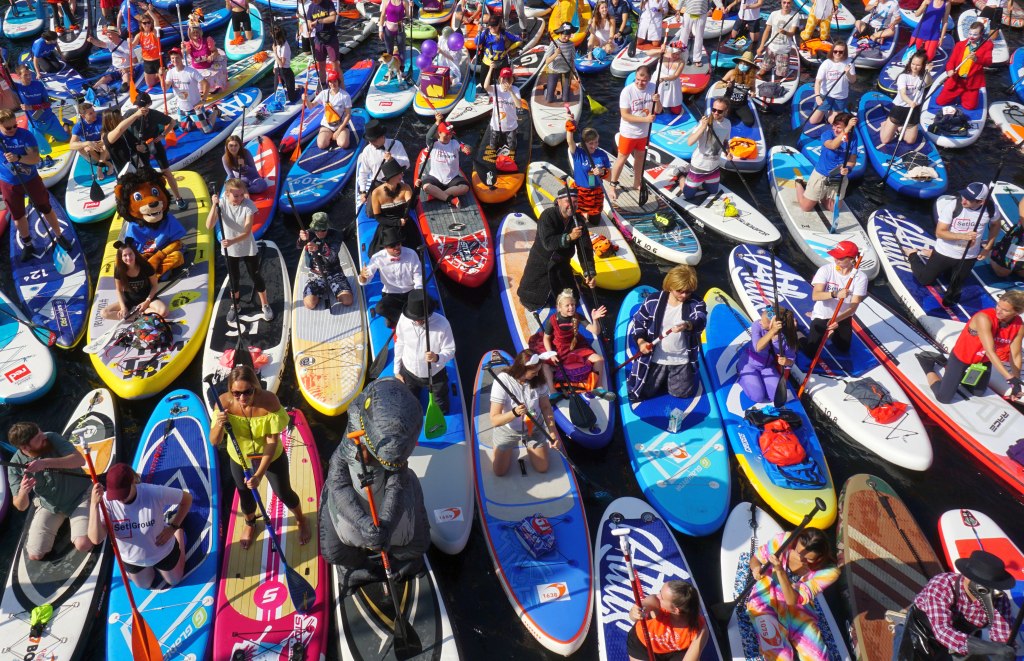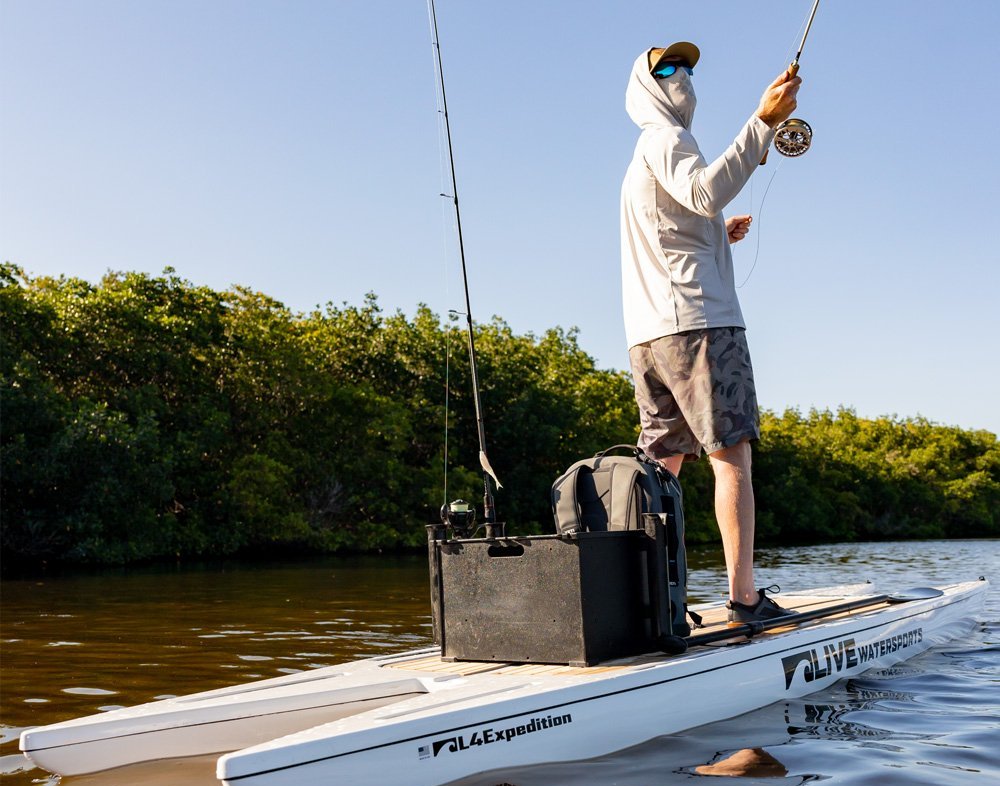If you want to combine Yoga and SUP, a standard recreational paddle board won't do. In this guide you'll find the best boards to use specifically for Yoga.

Here is our list of best SUPs for beginners and a guide to choosing the best beginner paddle board.
Summer is my favorite time of year. That’s when I get to break out my paddle boards and enjoy lake days with my wife.
This year, though, we’ve been bringing along our young adult kids and teaching them how to paddle board.
Which meant I had to find SUPs not suited to experienced paddlers like myself and my wife, but boards for newbies.
After testing every SUP I could get my hands on, talking to my fellow paddlers, and combing through thousands of product reviews, I’ve narrowed my options to a list of the absolute best paddle boards for beginners.
Read through the reviews below to find the SUP best suited for those new to paddling, and keep reading for a complete guide to choosing the best beginner paddle boards.
As an affiliate of Amazon and other retailers, we may earn a small commission when you buy via our links, at no additional cost to you. Thank you!
At A Glance: The 9 Best Paddle Boards for Beginners
Best All-Around: iROCKER All Around 11′ Inflatable Paddle Board
Speediest Ride: Blackfin CX Ultra
Most Stable: ISLE Switch
Best for Kids: Atoll 9’ Inflatable Paddle Board
Best for SUP Yoga: Gili Sports 10’6 Komodo
Best for Casual Paddlers: Bote Breeze Aero 10′8″ Classic Cypress
Best for Traveling: NIXY Newport G4 All Around Paddle Board – 10’6″
Best Premium: Red Paddle Co 10’6″ x 32″ Ride SUP Package
Best Budget: iROCKER Nautical 10’6
Comparison Table: The 9 Best Paddle Boards for Beginners
| Model | Specs | Where To Buy |
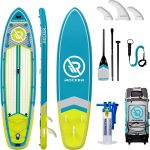 iROCKER All Around 11′ Inflatable Paddle Board | Size: 11’ x 32” Weight: 26 lbs. Weight Capacity: 400 lbs. | Amazon |
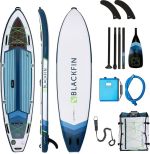 Blackfin CX Ultra | Size: 10’6” x 32.5” Weight: 19.8 lbs. Weight Capacity: 320 lbs. | Amazon |
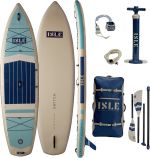 ISLE Switch | Size: 11’6” x 35.5” Weight: 19 lbs. Weight Capacity: 425 lbs. | Amazon |
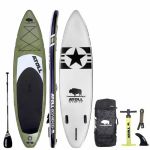 Atoll 9’ Inflatable Paddle Board | Size: 9’ x 30” Weight: 21 lbs. Weight Capacity: 315 lbs. | Atoll |
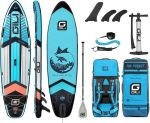 Gili Sports 10’6 Komodo | Size: 10’6” x 33” Weight: 21 lbs. Weight Capacity: 385 lbs. | Amazon |
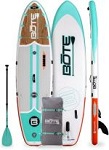 Bote Breeze Aero 10′8″ Classic Cypress | Size: 10’8” x 33” Weight: 20 lbs. Weight Capacity: 250 lbs. | Amazon |
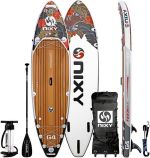 NIXY Newport G4 All Around Paddle Board – 10’6″ | Size: 10’6” x 32” Weight: 21 lbs. Weight Capacity: 300 lbs. | Amazon |
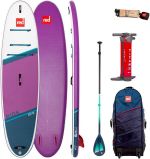 Red Paddle Co 10’6″ x 32″ Ride SUP Package | Size: 10’6” x 32” Weight: 20 lbs. Weight Capacity: 220 lbs. | Amazon |
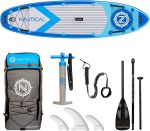 iROCKER Nautical 10’6 | Size: 10’6” x 32” Weight: 20 lbs. Weight Capacity: 240 lbs. | Amazon |
The 9 Best Paddle Boards for Beginners
Best All-Around: iROCKER All Around 11′ Inflatable Paddle Board
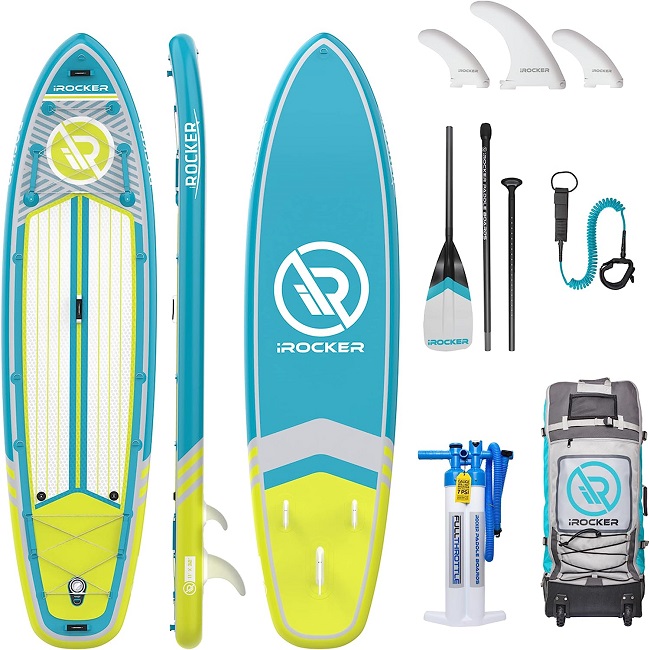
Length: 11’ (335.28 cm)
Width: 32” (81.28 cm)
Weight: 26 lbs. (11.79 kg)
Weight Capacity: 400 lbs. (181.44 kg)
Of all the paddle boards I’ve tested, I found this one overall to be the best for beginners.
At 11’ long and 6” thick, the iRocker All Around has high primary stability, which makes balancing easy for first-timers. However, it’s not too wide (32”), so it’s speedy and agile enough to help you master some more advanced paddling strokes.
I’m a big guy (250 pounds), so the 400-pound weight capacity was a huge bonus. It allowed me to store tons of gear without the risk of capsizing. It’s also sized right so my (much smaller) wife and daughter can ride it in tandem.
The board is beautifully tough, using triple-layer military-grade PVC with a drop-stitch core. It’s stiff, maneuverable (thanks to the long central fin and two accompanying skegs), and surprisingly speedy. Having tested it out, I’d say it’s well suited to all skill levels, with decent secondary stability on choppy waters.
If I had one complaint, it’s that the board is heavier than average (26 pounds). Still, I’ll take heavy in exchange for excellent durability.
Speediest Ride: Blackfin CX Ultra
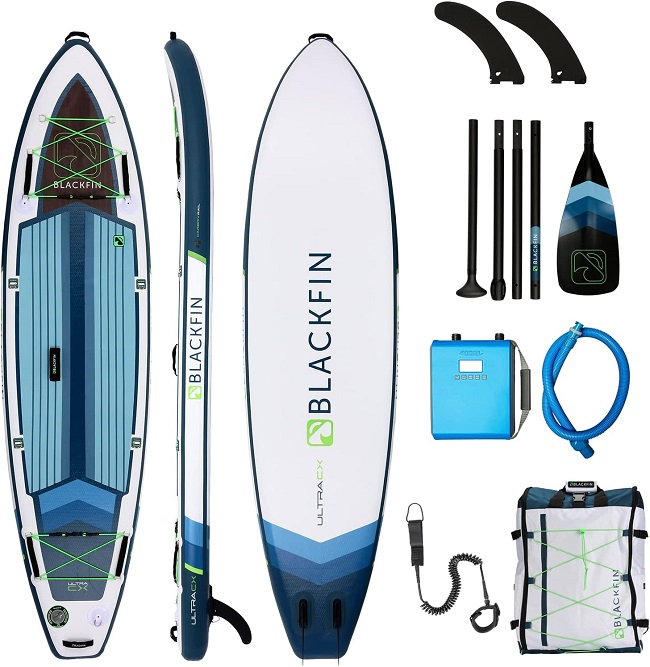
Length: 10’6” (320 cm)
Width: 32.5” (82.55 cm)
Weight: 19.8 lbs. (8.98 kg)
Weight Capacity: 320 lbs. (145.15 kg)
On those days I want to zip across lakes or down rivers, I’ll always choose the Blackfin CX Ultra over my other inflatable SUPs. At 10’6” long and 32.5” wide, it’s speedy, responsible, and incredibly agile. The drop-stitch construction and the integrated carbon rail make it a wonderfully stiff platform that I can push off against to drive maximum power into every stroke.
The 320-pound weight capacity is a bit lower than desirable if I take it fishing, but my son (around 180 lbs.) has no trouble loading it up with all his fishing gear without risking capsizing. Thanks to the extra D-rings along the board’s length and the front and rear bungee cord storage, there’s room on board the deck to pack all his fishing supplies safely.
One thing I loved about this board: it comes with iRocker’s electric pump included in the bag. I bought iRocker’s Portable Pump Battery to go with it, and now I can pump it up anywhere, anytime.
Most Stable: ISLE Switch
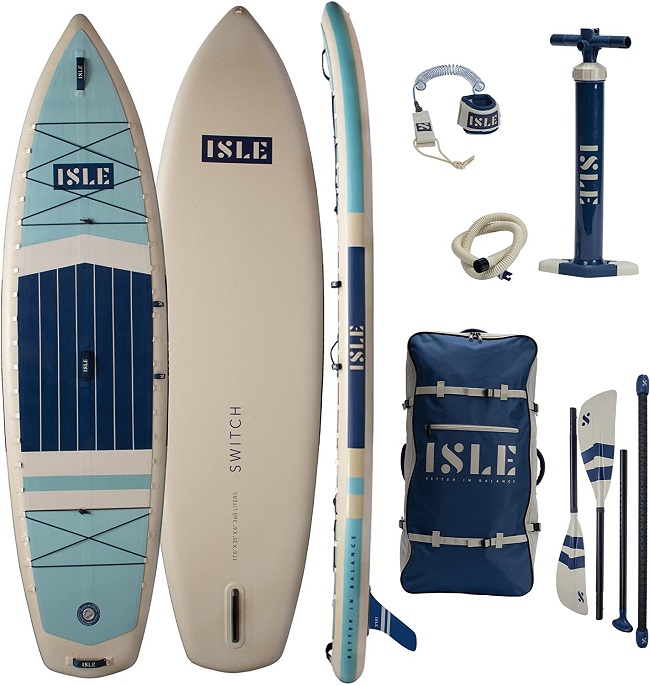
Length: 11’6” (350.52 cm)
Width: 35.5” (90.17 cm)
Weight: 19 lbs. (8.62 kg)
Weight Capacity: 425 lbs. (192.78 kg)
I’ve written up a detailed review of the Switch here, but suffice it to say, it’s the most stable of the SUPs I’ve tested to date. At 11’6” long and 35.5” wide, it’s rock steady on calm waters, and even my oversized frame couldn’t tip it over or capsize it.
Newbies struggling with their balance will love the Isle Switch’s extra-wide platform and grippy traction pad. It has amazing primary stability, but though it’s a bit extra-wide, it still handles well and tracks straight.
The fact that it converts between a kayak and SUP makes it a whole lot of fun to use, even for newbies who prefer sit-down paddling over stand-up paddling. Thanks to the ISLE-LINK system, it’s easy to adjust the seat and footrest and add extra accessories for a more enjoyable paddling trip.
It’s one of the pricier options on our list, but well worth it for its durability (and the 2-year warranty backing it). The Air-Tech Fusion Lite™ technology makes it both stiff and surprisingly light. All in all, it’s an SUP any beginner will love.
Best for Kids: Atoll 9’ Inflatable Paddle Board
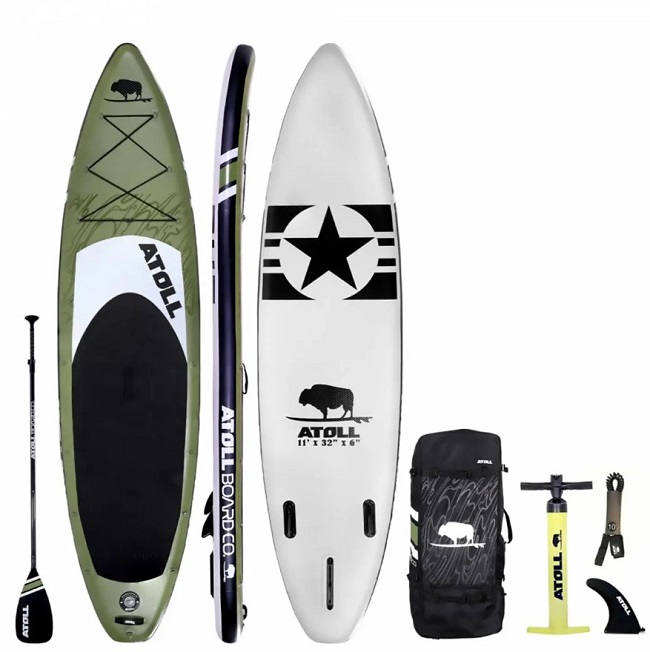
Length: 9’ (274.32 cm)
Width: 30” (76.2 cm)
Weight: 21 lbs. (9.53 kg)
Weight Capacity: 315 lbs. (142.88 kg)
If you’ve got kids just getting their bearings on the water, this 9-footer is the perfect investment. It’s tough enough to withstand their rough handling and has a high weight capacity to accommodate 2-3 smaller passengers.
At 30 inches wide, it’s not the most stable board around. However, it’s speedy, wonderfully responsive, and will serve your kids well when their paddling skills advance beyond beginner level.
The machine-laminated, dual-layer PVC and drop-stitch construction ensure that even if your kids treat it as roughly as they typically do (my boys somehow invented “paddle board jousting”), it’ll hold up well.
Best for SUP Yoga: Gili Sports 10’6 Komodo
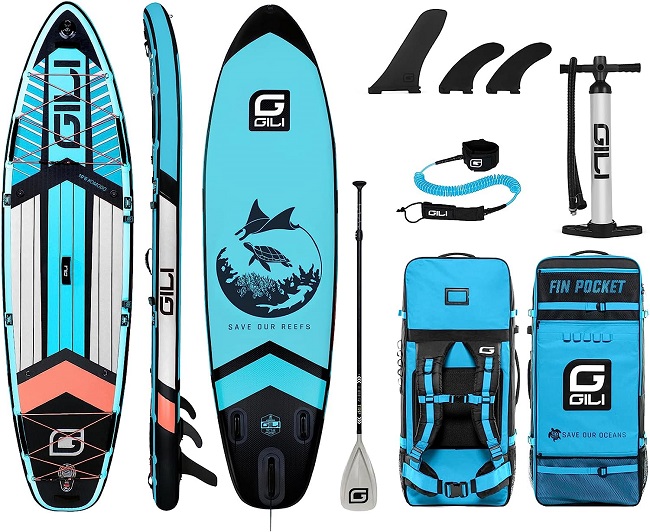
Length: 10’6” (320 cm)
Width: 33” (83.82 cm)
Weight: 21 lbs. (9.53 kg)
Weight Capacity: 385 lbs. (174.6 kg)
If you’re planning on mastering both basic paddleboarding skills and taking up SUP Yoga, the Gili Sports 10’6 Komodo is the board I’d recommend.
Though it doesn’t have a full-length soft deck, it does include a rear tail pad that gives your feet somewhere cushioned to press against when in inverse positions (like Downward Dog) or when you stretch your legs out (like in Warrior I). At 33” inches wide and 10’6” long, it’s wonderfully stable even for beginners.
Though it weighs just 21 pounds, it has an impressive 385-pound weight capacity. Bring your pets or kids on board, or pack extra gear for fishing, floating, or Yoga. Thanks to the removable bungee cord rigging on the front and back, you’ve got storage space for your Yoga blocks, towel, dry bag, and any other gear you want to bring.
I will say that it’s not the most agile board on the market. It’s designed for high primary stability and buoyancy, so don’t expect to get anywhere at high speeds.
But for beginners to SUP Yoga, it’s the best inflatable SUP I’ve tested.
Plus, Gili Sports’ customer service is excellent, and they offer a 2-year manufacturer’s warranty on the board.
Best for Casual Paddlers: Bote Breeze Aero 10′8″ Classic Cypress
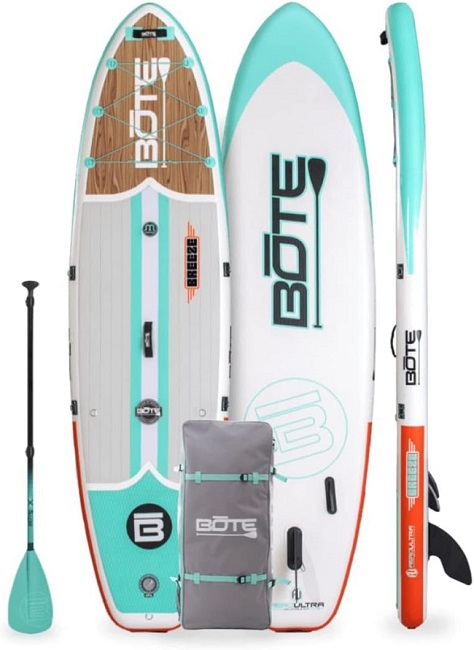
Length: 10’8” (326.12 cm)
Width: 33” (83.82 cm)
Weight: 20 lbs. (9 kg)
Weight Capacity: 250 lbs. (113.4 kg)
What I love about the Bote Breeze Aero line is that the boards are made to be lightweight but tough enough to handle regular use. You won’t win any races or have the best time exploring open seas, but this is an excellent board for newbies for paddling on a calm lake or river.
The SUP is fairly stable thanks to its 33” width and the combination of a long fin and twin skegs. However, it is best suited for smaller, lighter users (because of its 250-pound weight capacity).
You can’t bring much extra gear because it only has front bungee cord rigging. However, it’s compatible with all of Bote’s accessories (including their coolers or magnetic drinkware), which will be easily attached to the extra D-rings placed along the deck.
The military-grade single-layer PVC hull is sturdy and durable. Once inflated, Bote Breeze Aero creates a solid platform to stand and push off against.
Best of all, this board is backed by a 2-year warranty but is still one of the more affordable options on this list.
Best for Traveling: NIXY Newport G4 All Around Paddle Board – 10’6″
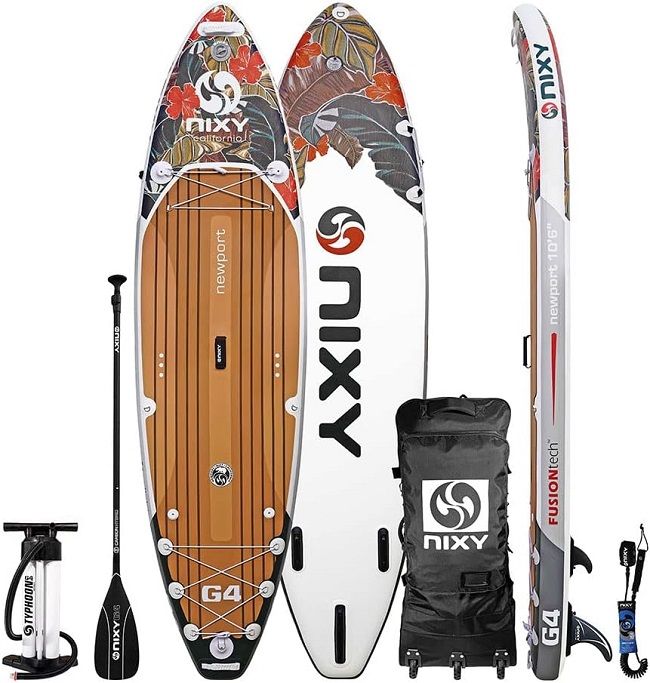
Length: 10’6” (320 cm)
Width: 32” (81.28 cm)
Weight: 21 lbs. (9.53 kg)
Weight Capacity: 300 lbs. (136 kg)
I bought this paddle board specifically for the bag!
I wanted something that I could easily take with me on my vacations. The wheeled bag this SUP comes with is so easy to pull around the airport, train station, or bus station. The 21-pound weight makes it nicely lightweight, too, so even my wife can load or unload it in a pinch.
The full-length deck pad makes for comfortable lounging. The ample D-rings and twin bungee cords offer plenty of space to load it up with gear and accessories. The board has 5 action mounts where I can install a fishing rod holder, camera mount, and drink holder.
The Newport G4 is built tough enough to handle international adventures, too. The advanced FusionTech dual-layer laminated military-grade PVC, woven drop stitch construction, and carbon fiber reinforced Side Rails make it stiff, stable, and durable.
Handling and tracking are easy thanks to the board’s 32-inch width, 10’6” length, and three removable fins (one long center fin, two skegs).
Be warned, though: this board does sacrifice a bit of stability in the name of speed and agility.
Best Premium: Red Paddle Co 10’6″ x 32″ Ride SUP Package
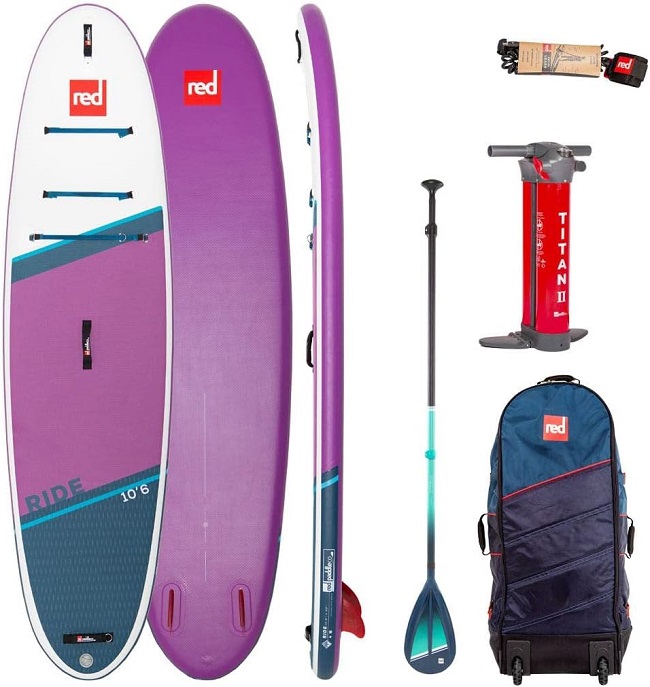
Length: 10’6” (320 cm)
Width: 32” (81.28 cm)
Weight: 20 lbs. (9 kg)
Weight Capacity: 220 lbs. (99.79 kg)
If you’d rather invest in one good paddleboard that will last you for years from beginner to advanced-level paddling, the Red Paddle Co 10’6″ x 32″ Ride SUP Package is my top pick.
Though it’s pricier (over $1,000), it’s built using ultra-durable MSL material and with “indestructible” fins that will last you a long time. Red Paddle is proud to back it up with a 5-year warranty—the longest of any inflatable SUP I’ve tested.
The 220-pound weight capacity means heavier paddlers like me can’t use it. Smaller-sized people will find it’s wonderfully speedy, nimble in the water, and even has good secondary stability, making it well-suited to SUP surfing or taking on coastal waters.
Rather than the standard bungee cord rigging, the board comes with a unique flat elastic strap system that lets you tie down gear tightly enough you won’t have to worry about it being washed overboard by a wave or in case of capsize.
The wheeled backpack makes it easy to haul this SUP anywhere you want to go, perfect for paddling in those hidden coves and secret beaches.
Best Budget: iROCKER Nautical 10’6
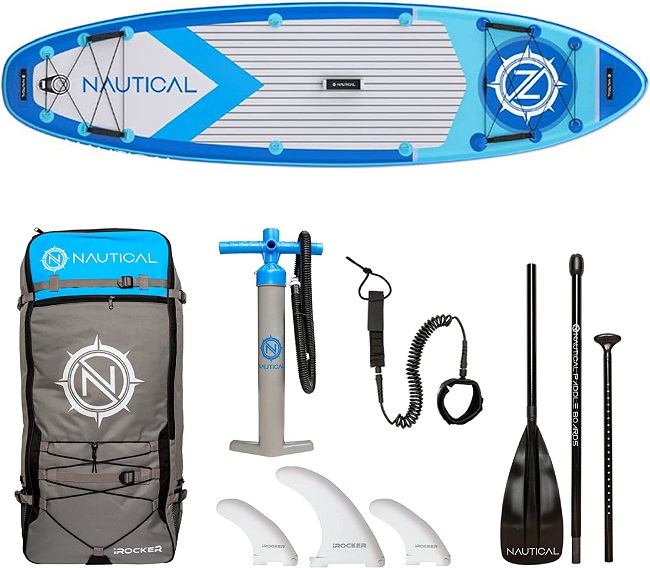
Length: 10’6” (320 cm)
Width: 32” (81.28 cm)
Weight: 20 lbs. (9 kg)
Weight Capacity: 240 lbs. (108.86 kg)
In all my research, I have yet to find an inflatable SUP that strikes such a good balance between a rock-bottom budget price tag and reliable construction. Many of the cheap knockoffs on Amazon are too flimsy and prone to defects.
iRocker’s Nautical line, however, does a great job of cutting costs without cutting quality.
The board is built for smaller beginners: 10’6” long, 32” wide, and 6” thick, with a weight capacity of just 240 lbs.
It’s stable enough you should have no problem mastering your balance, but it responds well and with good agility to your paddling strokes.
The Dual-Layer, Military-Grade PVC is tough, durable, and provides a nicely rigid platform to stand on. You’ll love the ¾-length deck pad, which gives you enough space to lounge comfortably or enjoy SUP Yoga.
It’ll handle best on calm lakes and slow-moving rivers. However, when I took it out onto the ocean off the coast of Vancouver, I found it a bit too tippy for my liking.
A Shopper’s Guide to Paddle Boards for Beginners
If you’re going to buy a SUP for someone new to the sport—be it yourself, your spouse, your kids, or a buddy—here are all the factors you need to consider when shopping for the best paddle boards for beginners:
Length
Paddle boards come in various lengths—from 8 to 16 feet. Each length is best suited to a specific purpose.
For example, kids’ paddle boards are usually shorter, in the 8 to 10-foot range. This makes them more maneuverable, and because kids are light, the lower weight capacity isn’t an issue.
Racing and touring boards are longer, typically in the 12 to 16-foot range. Longer boards track straighter and tend to have a higher weight capacity. However, they’re not very maneuverable; they’re made to be speedy but paddle in a fairly straight line.
The ideal length range for beginners is between 10’6” and 12’6”. In this range, the boards are long enough to be stable and have a good weight capacity without being too sluggish or hard to maneuver.
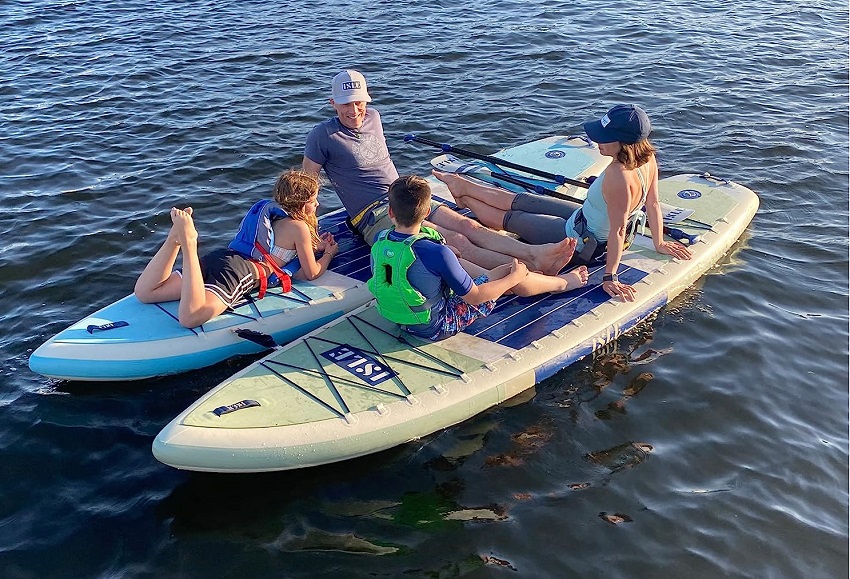
Width
SUP width is typically in the 32 to 36-inch range, though some (very few) can be narrower or wider.
Typically, surf SUP boards and racing boards are narrower because narrow boards are speedier and more agile. However, they are harder to balance, especially for newbies.
Very wide boards (35+ inches) are much more stable and hard for even new paddlers to tip over, but they are usually sluggish and harder to handle.
For newbies, the ideal width is between 33 and 34 inches. At that range, the board strikes the right balance between maneuverability, agility, and stability.
Thickness
Most beginner SUPs will be between 4 and 6 inches thick.
The thicker the board, the more volume it has, which translates into greater buoyancy.
Thicker SUPs have a higher weight capacity and greater primary stability (see the “Stability” section below). Still, they may not handle choppy waters as efficiently as thinner, sleeker boards with higher secondary stability.
For beginners, though, an inflatable SUP in the 4 to 6-inch-thick range will be the ideal choice.
Weight Capacity
One of the best things about inflatable SUPs is that they are filled with air.
Hard-shell SUPs tend to have a high-buoyancy foam core, but they are still heavier and thus ride lower in the water. They also have a significantly lower weight capacity.
The air-filled inflatable SUPs are very buoyant and sit on top of the water. The amount of weight required to submerge it is significantly higher. Even the weight required to tip it over is much higher than with a hard-shell SUP.
For this reason, most inflatable SUPs have a weight capacity of at least 250 pounds.
For my wife (5’3” and a weight I am not foolish enough to mention), that weight capacity is more than enough. For myself (6’6” and almost exactly 250 pounds), it’s putting me far too close to the “max weight capacity.” When I ride a board with this weight capacity, it tends to tip over more easily.
That’s why I have to find SUPs with a higher weight capacity. Ideally, I want something around 300+ pounds, which gives me more than enough to accommodate my weight, gear, and anything else I want to bring on board.
In a perfect world, try to find a paddle board with a weight capacity of 50 to 100 pounds higher than your body weight. That way, you can load up the SUP with a cooler, fishing gear, camping stuff, and anything else you want to bring, and you won’t compromise its stability.
Stability
There are two types of stability we need to discuss:
Primary stability refers to the SUP’s ability to remain stable on flat, calm water. An example of something with high primary stability would be a floating dock or a barge.
Secondary stability refers to the SUP’s ability to remain stable in choppy water. Kayaks typically have high secondary stability, as do sailboats that can tip with the ocean waves and swells without capsizing.
Secondary stability is very important for racing, touring, surfing, and open-sea paddle boarding. It will keep you from capsizing when going over rough water and waves.
But for beginners, primary stability is far more important.

The ability to remain stable on flat, calm water will let you master the balance and maneuvers needed to keep your SUP afloat and move across the water. Once you’ve got the basics down, you can upgrade to a paddle board better suited to handle waves and rough surf.
Most inflatable SUPs will have high primary stability and limited secondary stability. The longer, wider, and thicker a board is, the higher its primary stability will be.
Speed and Maneuverability
When starting with paddle boarding, you’re likely much more worried about staying upright and balanced than getting anywhere particularly quickly. You’re also not doing many sharp turns or navigating tight waterways that require a great deal of maneuverability.
That’s why many SUPs for beginners tend to prioritize stability above everything else. They’ll be thicker and wider, so they won’t handle as easily or turn so sharply.
Some beginner paddle boards are longer (11-12 feet), which allows for greater speed and straighter tracking. However, they’re less maneuverable than shorter, narrower SUPs.
Durability

Paddle boards are usually made from PVC, but how that PVC is crafted and joined plays a significant role in its durability.
Single-layer PVC is common on budget boards ($200 to $400 range). They’ll be tough enough for 1-3 years of beginner use. Still, you can expect them to have a much shorter lifespan overall, lower rigidity, and a greater likelihood of bending or being damaged with regular use.
Dual-layer PVC is standard on the mid-tier boards ($400 to $800 price range). Thanks to combining two layers of PVC joined by glue, they create a stiffer, more stable platform.
Fusion laminate PVC is used by only a few brands, and typically for the same mid-tier price range. The dual layers of PVC are fused by machines rather than joined by glue. The thicker material is stiffer and more durable but will also be heavier.
Triple-layer PVC is typically only utilized by higher-end boards, those built to be really tough and withstand a beating. Boards made using this material will usually start at $1,000. They’ll be the most durable option and will last the longest.
Drop-stitching involves using hundreds of tiny threads to join the two layers of PVC together. The drop-stitching doesn’t compromise the SUP’s ability to inflate, but creates a stiffer, more resilient bond that is less likely to be damaged even with frequent and heavy use. However, the extra weight of the threads makes the boards heavier. Drop-stitch technology also adds labor and material costs, so the boards tend to be pricier than average.
Basically, it comes down to how much you’re willing to spend.
Higher-priced boards use more materials and advanced technology, meaning they’ll likely last longer. Lower-priced boards are a great, cheap entry into paddling but won’t last long.
Must-Have Accessories

There are a few accessories you should look for in the best paddle boards for beginners:
- A good paddle. A good paddle with an aluminum shaft and carbon fiber head will be lightweight but responsive, so less energy is exerted with each stroke. Cheap plastic paddles will make paddling a whole lot more tiring.
- A leash. The leash ensures that the SUP is tethered to you. That way, when you inevitably fall into the water (trust me, it will happen), you don’t have to worry about the paddle board being pulled away from you by the current.
- Fins and skegs. A central fin goes a long way toward providing stability as it thrusts downward into the water and creates drag that keeps the board from tipping excessively from side to side. Skegs are smaller fins that work with the central fin to keep the board tracking straight. Any SUP with multiple fins or a fin and skegs will make handling and balance easier for beginners.
Bonus Accessories
There are a few accessories that aren’t essential for paddleboarding but are definitely “nice-to-haves” that make the experience more enjoyable and your SUP more versatile:
Gear mounts
These allow you to mount action cameras, fishing rod holders, and even trolling motor mounts on the SUP. They will be very handy once you expand the range of activities on the paddle board.
Full deck mat
If you’re planning on getting into SUP Yoga once you master the basics, a full deck mat will provide you with a soft, cushioned surface to spread out and do those Yoga poses safely.
Extra D-rings
Most paddle boards come with 2-8 D-rings, typically utilized by front and/or rear rigging. However, SUPs that have extra D-rings along its length will allow you to mount a kayak seat, strap down a cooler, attach a paddle keeper, and add on other extras that make for a more comfortable and enjoyable paddling trip.
More bungee cord rigging
All SUPs feature some form of onboard “storage” in the form of bungee cord rigging. Typically, budget boards only have front storage, which offers space for a dry bag and a few extra items. However, larger front storage and rear storage (at the back of the board) lets you carry more items without the need to lash or strap them to the deck.
Electric pump
Nowadays, some inflatable SUPs are being sold in a “kit” or “set” that includes the basic accessories and an electric pump.
Since I started using electric pumps to inflate my SUPs (rather than doing it by hand), my paddling trips have become much more relaxing and enjoyable.
It takes zero effort to inflate and deflate the boards, and I can kick back and relax with a drink while letting the pump do all the work for me.
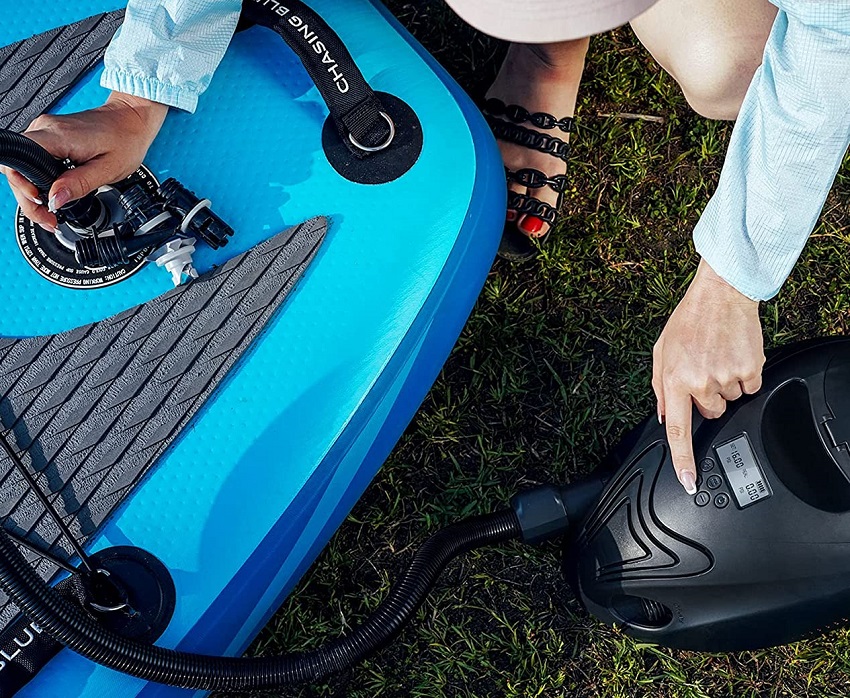
Customer Service
There exists a chance, however slim, that the SUP you order arrives defective or damaged. Or, perhaps, through no fault of your own, the board suddenly begins to leak or even pops.
When this happens, you’ll want to be sure you can contact the manufacturer and get a replacement board or a full refund.
Good-quality customer service is something to look for when SUP shopping. This is where you want to read over user reviews and find out what people have to say about the company. If there are many complaints about customer service—being unable to get in contact, difficult return process, hidden fees, etc.—steer clear of that brand and all its offerings!
Warranty
Every SUP company I’ve researched offers at least a 1-year warranty. This is great for covering any defects or flaws that might present within the first few months of use.
But if you plan on paddle boarding for longer than a season or two (which you likely will when you see how much fun it is!), you’ll want a warranty that offers longer protection.
For example, I bought a Naakua board in early 2022 to have it available for the summer. A year later, however, come summer 2023, when it suddenly pops while just sitting on the lake shore waiting to be used, I no longer am covered by warranty, so all the money I spent on that board is gone.
I recommend that you look for SUPs backed by a 2-year warranty (offered by many mid-tier SUP brands) or even a 4-year warranty (offered by the higher-end brands). That way, you’ll get your money’s worth in the long run!
Price
Price is a factor to consider insofar as it relates to the quality of the board. The higher the price, the higher the quality is likely to be.
Boards in the $200 to $400 range do exist, but they tend to be cheaply made, perform poorly, and won’t last for more than 1-3 years on average.
However, kids’ SUPs in this price range may be worth considering, given how rough kids tend to be on their toys and the real probability that they could lose interest in paddling within a year or two.
Boards in the $400 to $800 range strike a decent balance between durability, reliability, performance, and affordability. Some will be backed by a 2+ year warranty and built with more resilient construction (including drop-stitch technology and multi-layered PVC).
For beginners, I recommend you stick within this price range. You can always scale up when ready to take your paddling to the next level.
Boards in the $1,000+ range will be better suited to more advanced paddlers or come with more bells and whistles. If you plan on paddling for years to come, investing in a higher-quality, more versatile, better-performing board that you can keep using season after season is a good idea.
However, that initial investment may be slightly higher than you’d like.
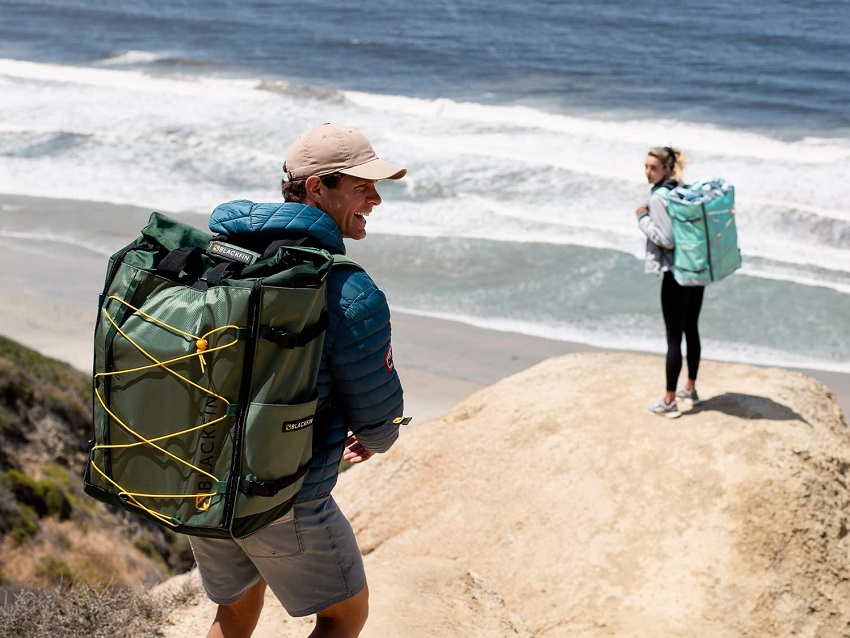
Best Paddle Boards for Beginners FAQs
Stability is the most important thing to look for in your first paddle board. That likely means a slightly longer, wider, and thicker board. It may be more sluggish than the shorter, narrower, and speedier boards, but it will help you master the balance and basic paddling strokes.
Absolutely! Inflatable paddle boards have higher buoyancy, so they will float on top of the water rather than riding mostly submerged like hard-shell SUPs. They’ll also be more stable and make it much easier for you to master the balance and paddling basics.
Inflatable paddle boards are surprisingly difficult to flip. The board will likely tip over when you fall off but remain right-side-up due to its high buoyancy and primary stability. That makes them easier to re-mount.
I mastered the basics of balancing and paddling within 3-4 weeks of my first time out on the water. My wife took more like 2-3 months. I have friends who have been paddle boarding for years (they started before me) and still struggle to stand upright. Your results will vary depending on your natural agility, athleticism, core strength, and balance.


